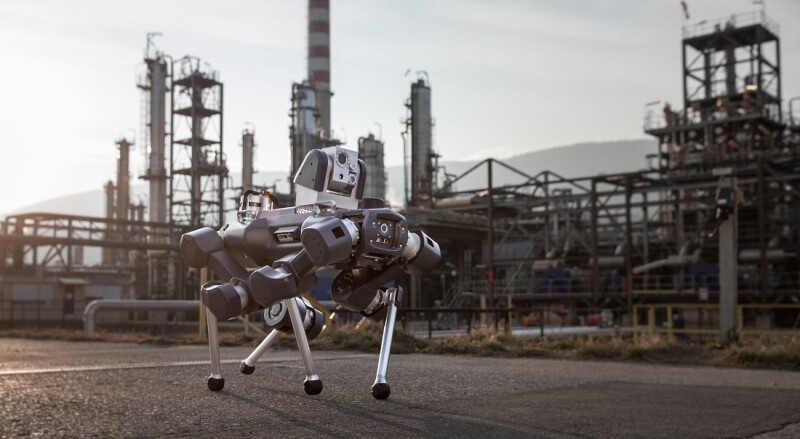Swiss robotics company ANYbotics introduced ANYmal X, the first explosion-proof legged robot, at the Offshore Technology Conference (OTC) Asia. ANYmal X is intended to automate routine inspections for oil and gas and chemical industries. It is the first such robot specifically designed and certified for safe usage in explosive environments.
Oil and gas and chemical operations are complex, and safety is paramount. Plant operators must pay special attention to the infrastructure where flammable and explosive matter is processed. Ensuring availability and safety in these operationally intricate facilities requires frequent inspections and detailed monitoring. Often, these inspections must be performed in or close to hazardous environments, therefore all equipment must be certified as safe for use in explosive atmospheres. This means that any equipment used in these areas must be guaranteed not to cause an explosion, even in the presence of high levels of combustible material.
ANYmal X has IECEx and ATEX certifications for usage in Zone 1 explosive atmospheres. “Having ANYmal X ex-certified up to Zone 1 will really enable us to bring the robot very close to our process area, and that’s where you create value,” said Iskandar Al-Thani Mahmood, manager of robotics for Petronas.
For the oil and gas and chemical sectors, robot inspection solutions reduce health, safety, and environment risks and operational expenditures, including the cost of transporting inspection specialists offshore. Autonomous robotic inspections can reduce manual work and workers’ exposure to hazardous environments. They also can eliminate plant shutdowns for inspections and reduce unplanned downtime.
“For a first time, ANYmal X closes an important technical gap, conducting automated inspections in very complex environments, with stairs and tight passages,” said Peter Welter, automation manager at BASF. “This, in combination with ex-zones, that’s a novelty.”
At OTC Asia in Malaysia, Petronas and ANYbotics signed a commercial agreement to scale ANYmal X deployments to upstream and downstream facilities and to promote the use of ANYmal X across the industry up until 2025.
ANYbotics said its customers intend to deploy more than 300 units over the next few years and that it is planning for additional deployments of ANYmal X this year.
Petronas has been working with ANYbotics on ANYmal X since 2019. Several other companies have signed up for the ANYmal X onboarding program, including Equinor, Petrobras, Woodside, and Shell.
“Our offshore and onshore assets require ex-certification in certain areas. Robots moving in these areas would, therefore, need to be certified. For this reason, we are taking part in the ANYmal X onboarding program,” said Anders Røyrøy, principal researcher for automation at Equinor.
To enable seamless introduction of inspection robots to operations, ANYbotics developed an early-adopters program. The program underpins the cross-functional embracing of robotics and prepares the partner organizations for scaling. Central to the program are ANYmal X trial deployments. The program includes workshops and training on operational safety, security, and standard operating procedures.
In addition to visual inspections, potential tasks for the ANYmal X include automated readouts of analog instruments such as gauges, liquid levels, and lever positions; advanced thermography and vibration analysis of equipment; and 3D scanning of infrastructure. ANYmal X is equipped with gas-detection sensors to monitor the presence of methane, carbon monoxide, hydrogen sulfide, and other gasses. Its software integrates with asset-management software and digital twin platforms such as Cognite Data Fusion and Woodside Fuse.
For safe use in hazardous and potentially explosive environments, all systems need protection against gas ignition. Robots work with motors, electronics, batteries, and, in ANYmal X’s case, self-contained systems. Temperature control, therefore, is complex. No suitable components exist yet, so ANYbotics developed components for an advanced thermal management system. In addition, the ANYmal X drivetrain needed multiple redundancies. Such systems are not typically found in robots, so the team effectively reengineered standard heavy machinery protocols to meet weight, mobility, and explosion-proof requirements. The result is that all optics and sensors are fully functional while being protected.
The robot’s controller works with any tablet.
“Integrating autonomous robots into oil and gas and chemical workforces is now not only possible but effortless,” said Mario Mauerer, ANYbotics’ chieft technology officer for hardware.

